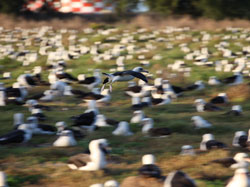
Physical Feature: By Wind, Wave and Wing
The Hawaiian Archipelago is the remotest island chain on Earth, with the closest continental land mass 2,600 miles away. Additionally, the Hawaiian Islands were formed from a volcanic hot spot in the center of the North Pacific Ocean and there is no geologic connection to any continent. This isolation makes colonization by plants and animals very difficult. The hot spot has been creating islands in Hawaiʻi for at least 80 million years, and during this time the natural rate of successful colonization is estimated to be roughly one species every 35,000 years. Species arrive in the form of seeds, spores, insects, spiders, birds, and small plants. Seeds, spores and small insects are carried in the feathers of birds, or may even be carried on the wind. Some spiders make billowy webs, like parachutes, that can help carry them aloft and drift across the vast Pacific on the jet stream. Waves and currents transport marine organisms, and can carry some salt hardy seeds, as well as rafts of debris that may contain seeds, spores, insects, and small plants. This isolation, and infrequent colonization has allowed Hawaiʻi to develop very unique ecosystems, with many species - cut off from their parent stock - evolving over thousands of years into unique species found nowhere else on Earth. With the advent of the modern era, and ships, airplanes, and commercial traffic, this slow ecological process has been vastly accelerated and the current natural rate of species introduction is estimated at 2 million times the natural rate. This "silent invasion" is having a major impact upon fragile Hawaiian ecosystems, and causes many species to go extinct at an accelerated rate. You can do your part to protect the ecosystems of Hawaiʻi by supporting efforts to control introductions, and checking your personal belongings for unwanted hitchhikers when coming to Hawaiʻi or even travelling between areas of Hawaiʻi.
Click Here for more information (you will be directed to a non-NOAA website).

